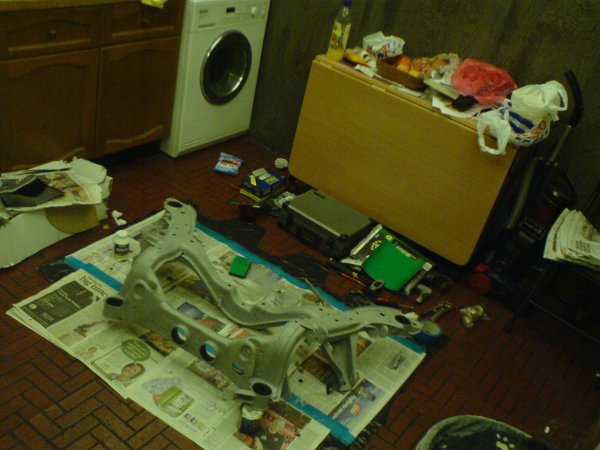I’ve released Vigilance, I’ve been sick all weekend, I’ve been repainting a subframe (more on that later)… it’s been pretty hectic!
Well.. mostly, I’ve been ill. But while I was ill Vigilance went up on Newgrounds, got reviewed on JIG (“a side-scrolling beat-em-up fighter with an artsy, ironical soul, where you kick unconscious people on the ground… to save them“) and is basically taking over the Internet. Top stuff.
So… work this week! It’s about half Fight Back and half… car maintenance.
I’m currently polybushing my car, which involves removing all the soft bits of rubber and replacing them with cats polyurethane. To do this I need to disassemble my car’s suspension and entire rear axle, then put it all back together with a replacement subframe and brand new bushes by Saturday. I’m currently repainting the new (second hand) subframe, having stripped all the rust off it earlier, and it’s currently sitting in the kitchen with a coat of primer curing. I’ll slap on another coat of primer this evening and a topcoat tomorrow, then start really dismantling stuff and swapping parts over on Thursday/Friday.
Yep. This is our kitchen this week:
Needless to say that’s going to take up a bunch of my time over the next few days – and Elizabeth has the patience of a saint. 😀
In the gaps between Urgent Car Maintenance Task, I’ll be working on Fight Back. There’s a similar level of deconstruction and reassembly involved here! I’m totally overhauling the game’s codebase to support the following:
- a component-based entity system
- event-driven, deterministic simulation
- a totally decoupled renderer
- framerate independence with interpolation
- zero allocations per frame
What does all that mean in English?
- I’ll be able to easily change the graphics. I’d be able to switch to a lower-res version of the game on the fly to support less powerful machines. I’d be able to support a 3D version with Flash Player 11, or support different resolutions on PC, iPhone, iPad, etc.
- It’ll be able to support networking. All the necessary things would be in place for a robust peer-to-peer or client-server networked multiplayer mode.
- It’ll run really smoothly on damn near anything. 😀
Now, I’m not guaranteeing I’ll add multiplayer or make it 3D or put out an iPhone version or anything. I just want to keep these options available. All this refactoring will give me a much more solid foundation to press onwards with.
Wish me luck. I’ll try and get enough done that I have screenshots with some of the new graphics by Wednesday. 🙂
